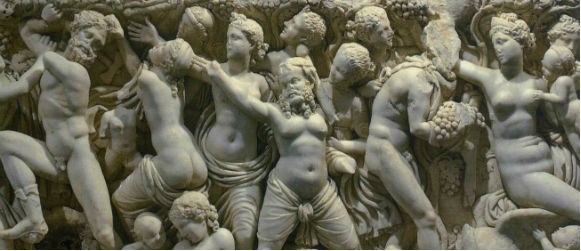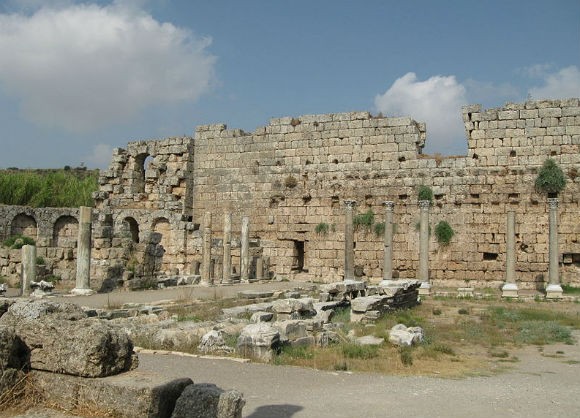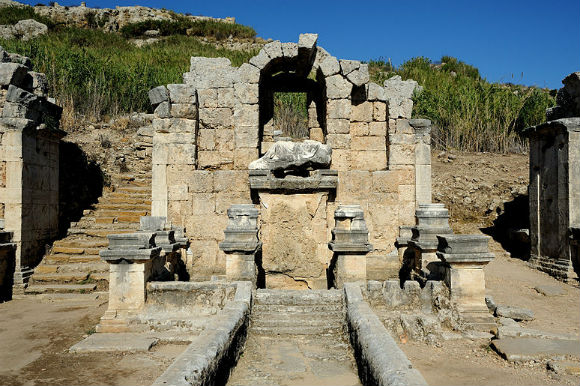Perga was an old city even in the first century. Its name (which is not Greek) indicates that its origin dates from pre-Greek times. Alexander the Great passed through it twice while the Pergaeans offered no resistance to him although it was a walled city with a citadel. In Roman times the main streets were over twenty-one meters wide. They were lined with Ionic colonnades and a water channel ran down their center in a series of small waterfalls as in Antalya today. Behind the colonnades stood the shops. Of the early buildings the stadium and the theater have survived the ravages of earthquakes and wars with the least damage. In fact this stadium which could seat about fourteen thousand people is one of the best preserved in Turkey.
The temple of the Pergaean Artemis according to a writer of the time was “a marvel of size, beauty, and workmanship.” Its location has yet to be established; it may have been where there are now ruins of a Byzantine church on a hill to the southeast of the city.
Perga is on a rise not far from the Cestrus River which was navigable In Paul’s time. It was not a seaport in terms of Its being directly on the Mediterranean even then, but rather it was more easily defended where it was: its distance from the open sea made it less vulnerable to piracy.
Two people stand out among the early residents of Perga. Apollonius was a third century B.C. astronomer and mathematician who believed that the movements of heavenly bodies in the universe were explainable by orbits within orbits: that the moon went around the earth as the earth went around the sun. He was much ahead of his time in his theories of astronomy, so much so that the ideas had to be rediscovered during the Renaissance. Plancia Magna was unusual for a second century A.D. woman: she held the highest city office during her life, that of demiurgus. She must have been well-to-do for a number of inscriptions record her gifts to the city.
Paul and Barnabas went through Perga on their way to and from Antioch on their first journey (Acts 13:13, 14:25). John Mark was with them at first but left them at Perga to return to Jerusalem. The reason for that must have been such that Paul doubted his commitment to the cause. Later when Paul and Barnabas were about to start on their second journey from Antioch they had a sharp dispute over his worthiness. Paul refused to have him go along, so John and Barnabas went to Cyprus while Paul chose Silas to accompany him.
Paul talks in II Corinthians 12:7 and in Galatians 4:13-14 of bodily illness that brought him to Galatia the first time. It may have been on that account that he did not stay long in Perga the first time. Whatever the illness was, it seems to have improved in time in the dry mountain air to the north.
The second theory of why they did not stay long in Perga is that their interview with Sergius Paulus, the proconsul of Cyprus, had made them want to hurry to the Roman colony in Antioch of Pisidia. This interpretation may lay too much stress on the lasting importance of that meeting with a cultured Roman who could have been more interested in the pursuits of the mind than the salvation, in Christian terms, of his soul. It is interesting, however, that this is” the point in Acts (13:9) that Luke begins to call Paul by his Roman name, not his Jewish “Saul”.
On their return they did stay in Perga long enough to preach and talk with people there. Nothing else is told about the city or their time there.
Perga,






If you are interested in archaeology this is one place that will interest you. It is one of the better ruin sites I have seen.Not to be missed. Mainly level ground.
Spend an hour or two looking at these ruins. I saw the tail of a snake disappearing between some of the stones, but I think it was of a non venomous species. Bring water in the summertime.
antics and statues, Stg Paul's birth place a theatre a stadium and an old street. Make sure to have enough time for all this
We went there in july 2011. on our own. We hitchiked from Antalya, no problem at all. We loved the place, very well preserved ancient ruins, both greek and romans. Dont forget about the heat and protect your head from the sun, and drink water. On the day we decided to go there it was over 40 degree. We stayed…
I consider this as a must to see, when visit Antalya or Belek, particularly if you are curious about the Roman and Greek history, and the interaction with the Turkey in the past. The ruins was well maintained and preserved. The acropolis is still in the excavation, but the pillars, ruins of roman bath, and the market street can easily…
We travelled to Perge from Side by car (took just under an hour) – the site cost 15 lira each to enter (currently around £5). We purchased a guide book for 1 lira and toured the site without a guide, which meant that we could go at our own pace and – when we timed it right – we saw…
After the grandeur of Ephesus and volumous Hierapolis, Perge can seem like a bit of a let down. But it is the best preserved and most extensive site near Antalya and if you are staying there you should go see this Roman City.
It has a beautifully preserved Agora (marketplace) with many standing columns that give a hint of the…
Very beautiful place, magnificent scenery. we went on august this year, not really recommended if u r sensitive to heat, my gf didn't enjoy it as much as i did, also there are many excavation areas that are prohibited, and the ruins are not taken care of as it was in other countries, but still u get that indiana jones…
Fascinating trip, although it was baking hot the day we went. It's an on-going archeological dig that was really well explained by our guide who gave a insight into B.C.civilisations.
The best hypo cause I've seen Plunge pools clearly visible Just neeeded Cleopatra to have stayed there though St Paul comes close.